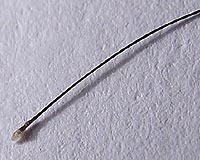 |
Ann Arbor MI (SPX) Feb 24, 2011 The Mimosa plant, which folds its leaves when they're touched, is inspiring a new class of adaptive structures designed to twist, bend, stiffen and even heal themselves. University of Michigan researchers are leading their development. Mechanical engineering professor Kon-Well Wang will present the team's latest work at the American Association for the Advancement of Science's 2011 Annual Meeting in Washington D.C. He will also speak at a news briefing earlier that day. Wang is the Stephan P. Timoshenko Collegiate Professor of Mechanical Engineering and chair of the Department of Mechanical Engineering. "This is quite different from other traditional adaptive materials approaches," Wang said. "In general, people use solid-state materials to make adaptive structures. This is really a unique concept inspired by biology." Researchers at U-M and Penn State University are studying how plants like the Mimosa can change shape, and they're working to replicate the mechanisms in artificial cells. Today, their artificial cells are palm-size and larger. But they're trying to shrink them by building them with microstructures and nanofibers. They're also exploring how to replicate the mechanisms by which plants heal themselves. "We want to put it all together to create hyper-cellular structures with circulatory networks," Wang said. The Mimosa is among the plant varieties that exhibit specialized "nastic motions," large movements you can see in real time with the naked eye, said Erik Nielsen, assistant professor in the U-M Department of Molecular, Cellular and Developmental Biology. The phenomenon is made possible by osmosis, the flow of water in and out of plants' cells. Triggers such as touch cause water to leave certain plant cells, collapsing them. Water enters other cells, expanding them. These microscopic shifts allow the plants to move and change shape on a larger scale. It's hydraulics, the researchers say. "We know that plants can deform with large actuation through this pumping action," Wang said. "This and several other characteristics of plant cells and cell walls have inspired us to initiate ideas that could concurrently realize many of the features that we want to achieve for adaptive structures." Nielsen believes nastic movements might be a good place to start trying to replicate plant motions because they don't require new growth or a reorganization of cells. "These rapid, nastic motions are based on cells and tissues that are already there," Nielsen said. "It's easy for a plant to build new cells and tissues during growth, but it's not as easy to engineer an object or machine to completely change the way it's organized. We hope studying these motions can inform us about how to make efficient adaptive materials that display some of the same types of flexibility that we see in biological systems." When this technology matures, Wang said it could enable robots that change shape like elephant trunks or snakes to maneuver under a bridge or through a tunnel, but then turn rigid to grab a hold of something. It also could lead to morphing wings that would allow airplanes to behave more like birds, changing their wing shape and stiffness in response to their environment or the task at hand.
Share This Article With Planet Earth
Related Links University of Michigan Space Technology News - Applications and Research
 Turning To Nature For Inspiration
Turning To Nature For InspirationEvanston, IL (SPX) Feb 23, 2011 To build the next generation of sensors - with applications ranging from medical devices to robotics to new consumer goods - Chang Liu looks to biology. Liu, professor of mechanical engineering and electrical engineering and computer science at Northwestern University's McCormick School of Engineering and Applied Science, is using insights from nature as inspiration for both touch and flow ... read more |
|
| The content herein, unless otherwise known to be public domain, are Copyright 1995-2010 - SpaceDaily. AFP and UPI Wire Stories are copyright Agence France-Presse and United Press International. ESA Portal Reports are copyright European Space Agency. All NASA sourced material is public domain. Additional copyrights may apply in whole or part to other bona fide parties. Advertising does not imply endorsement,agreement or approval of any opinions, statements or information provided by SpaceDaily on any Web page published or hosted by SpaceDaily. Privacy Statement |